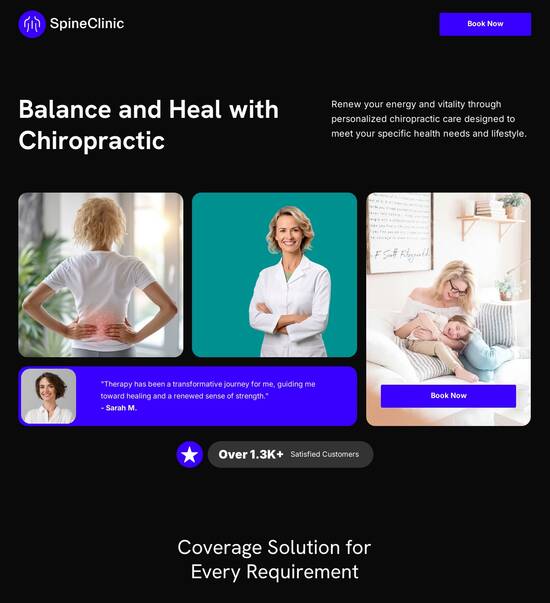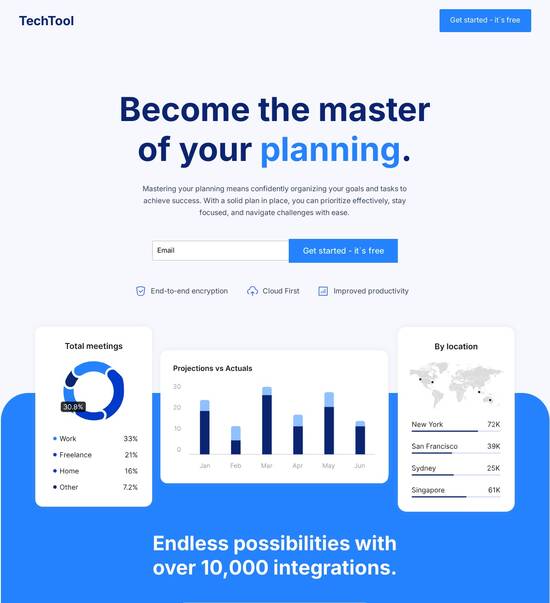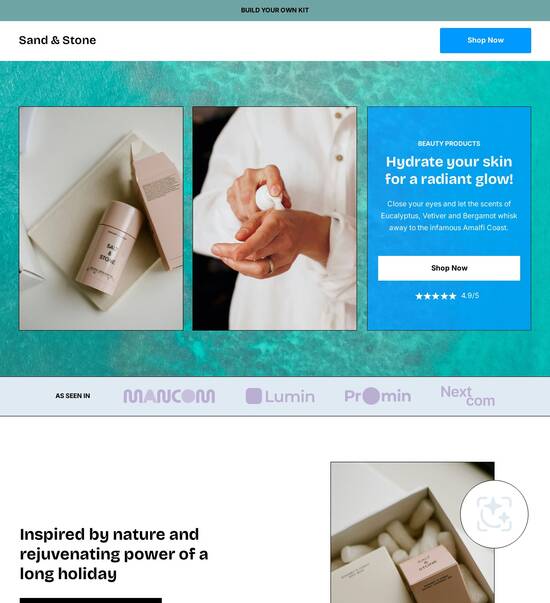
JQuery optimized checkout page template
Explore Similar TemplatesAbout template
Supercharge your checkout page with jQuery for outstanding performance! Learn more today.
Recommended templates

Easy to build without coding
With the intuitive drag-and-drop builder, anyone on your team can create high-converting pages without any knowledge of code or design. Make enhancements to your landing page with custom widgets using Javascript, HTML/CSS, or third-party scripts.

Multiple layouts for any industry and goal
Select from 500+ landing page layouts built to boost conversions across industry-specific scenarios. Customize them by adjusting fonts, adding images, and generating on-brand content with the AI assistant. Quickly scale with Instablocks® and Global Blocks that you can save, reuse, and update globally.

Loads fast and looks polished on any device
Every template is responsive, which means they present professionally on any device and load blazingly fast with our Thor Render Engine. You can also power them up with Google AMP technology to deliver an unparalleled mobile experience and drive higher conversions.

Robust analytics & experimentation
Get real-time updates and reporting across all your devices, showing the number of visitors, conversions, cost-per-visitor, and cost-per-lead. Launch AI-powered experiments, run A/B tests, and use heatmaps to analyze user behavior, then optimize your landing page to maximize conversions.







Easy to build without coding
With the intuitive drag-and-drop builder, anyone on your team can create high-converting pages without any knowledge of code or design. Make enhancements to your landing page with custom widgets using Javascript, HTML/CSS, or third-party scripts.
Multiple layouts for any industry and goal
Select from 500+ landing page layouts built to boost conversions across industry-specific scenarios. Customize them by adjusting fonts, adding images, and generating on-brand content with the AI assistant. Quickly scale with Instablocks® and Global Blocks that you can save, reuse, and update globally.
Loads fast and looks polished on any device
Every template is responsive, which means they present professionally on any device and load blazingly fast with our Thor Render Engine.
Robust analytics & experimentation
Get real-time updates and reporting across all your devices, showing the number of visitors, conversions, cost-per-visitor, and cost-per-lead. Launch AI-powered experiments, run A/B tests, and use heatmaps to analyze user behavior, then optimize your landing page to maximize conversions.
All the features you need to build lead-generating landing pages
Explore more featuresLearn how to build top-performing landing pages for any goal
FAQs
Leading the way in building high-performing landing pages





Mastering Instapage for High-Conversion Landing Pages
Instapage is the most powerful platform for creating and optimizing landing pages, designed specifically to enhance the performance of your digital marketing campaigns. For marketers in sectors such as business services, tech, education, energy, and financial services, utilizing Instapage's cutting-edge tools can significantly boost your ROI. This step-by-step guide will walk you through the optimal usage of Instapage, ensuring your campaigns achieve maximum impact.
Understanding the Power of Instapage
With over a hundred templates and lead generation elements, Instapage empowers you to kickstart your campaigns without any need for coding. Whether you're in the marketing and advertising field or a tech/SaaS company, the ability to rapidly deploy customizable landing pages is crucial. Instapage’s user-friendly interface allows you to focus on creativity rather than the technicalities of page creation.
- Fast Deployment: Quickly launch tailored landing pages that meet your marketing goals without technical delays.
- Enhanced Lead Capture: Utilize built-in lead generation features to gather valuable user information effortlessly.
- High Conversion Rates: Leverage high-converting templates that are optimized based on previous successful campaigns.
Crafting Your First Landing Page
Creating a landing page that converts is a straightforward process with Instapage. Start by choosing a template from the extensive library, then customize it using the drag-and-drop editor.
Optimizing Landing Pages for Conversion
Enhance your landing page’s performance through continuous optimization.
- A/B Testing: Experiment with different layouts, colors, and calls-to-action (CTAs) to find what resonates best with your audience.
- Heatmaps: Analyze user behavior with heatmaps to understand where visitors click the most.
- Analytics Dashboard: Use the comprehensive analytics dashboard to track performance metrics and refine your strategy.
Leveraging Personalization Techniques
Personalization is key to engaging your audiences effectively.
- Dynamic Text Replacement: Tailor headlines and content automatically based on the visitor's source.
- Ad Mapping: Align specific ads to relevant landing pages to ensure coherent user journeys.
- Audience Tracking: Monitor metrics at the audience level to assess and enhance targeting strategies.
By employing these strategies, you can ensure your landing pages not only attract clicks but also convert visitors into leads and customers.
Ready to elevate your digital marketing efforts? Start building high-converting landing pages with Instapage today!
jQuery optimized checkout page template
Understanding the significance of an optimized checkout page
Checkout pages are often the final point of contact between a customer and an e-commerce platform, playing a crucial role in determining the overall success of online sales. Their importance lies not only in facilitating payment but also in converting potential buyers into loyal customers. A well-designed checkout page can significantly impact conversion rates by minimizing cart abandonment, ensuring that customers feel confident and satisfied throughout the purchasing process.
In addition to lifting conversion rates, an optimized checkout experience enhances user retention. Effective checkout processes make it easy and enjoyable for customers to complete transactions, encouraging them to return for future purchases. An understanding of the intricacies involved can help marketers improve performance and customer loyalty.
Impact on conversion rates: Streamlined processes lead to higher purchases.
User experience and retention: Satisfying checkouts build loyalty.
Key components vital to an effective checkout process include simplicity, mobile responsiveness, and robust security features. A simple design with clear navigation allows customers to proceed without friction, while mobile responsiveness ensures a seamless experience on all devices. Lastly, integrating dependable security measures is crucial to fostering customer trust.
Introduction to jQuery in web development
jQuery is a fast and concise JavaScript library designed to simplify HTML document traversing, event handling, and animation. Its purpose is to make things easier for developers, quickly enabling them to create web functionalities with less code. Its historical significance cannot be understated, as it revolutionized how web designers and developers approached user interactivity, providing essential tools and features that would otherwise require a more complex codebase.
One of its standout features lies in its ability to enhance user interactivity. By utilizing jQuery, developers can manipulate dynamic content effectively and respond to user actions seamlessly through event handling capabilities. This results in a more engaging user experience, particularly in high-traffic areas such as checkout pages.
Overview of jQuery: A powerful JavaScript library for simplifying web development.
How jQuery enhances user interactivity: Dynamic manipulation and responsive design.
Essential features of a jQuery optimized checkout page template
A jQuery optimized checkout page should prioritize smooth user navigation through a guided checkout process. By breaking the process into manageable steps, customers can focus on completing their tasks without feeling overwhelmed. Additionally, implementing real-time validation messages within form fields reassures users that their inputs are accurate, reducing frustration and potential abandonment.
Another critical feature is responsive design elements that adapt seamlessly across various devices. An effective template must recognize and adjust to the changing size and capabilities of screens, thus ensuring that mobile users enjoy an equally effective experience as desktop users. Including touch-friendly components further cater to mobile shoppers, making interactions simple and intuitive.
Smooth user navigation through step-by-step processes.
Real-time validation messages for form inputs.
Responsive design elements for mobile adaptability.
Touch-friendly components for user ease.
Finally, enhancing loading speed is paramount. Utilizing asynchronous loading techniques and minimizing HTTP requests can significantly reduce page load times, creating a more enjoyable checkout experience. Customers are less likely to abandon a purchase if the process is quick and efficient.
Innovative functionalities of the jQuery checkout template
User-friendly form fields equipped with auto-fill capabilities can dramatically enhance the checkout experience. By allowing users to populate fields quickly based on previous inputs or saved information, the process becomes less tedious and more efficient. This is particularly valuable for returning customers who want to complete purchases swiftly.
Inline error notifications provide immediate feedback, enabling users to correct mistakes before proceeding. This not only speeds up the checkout process but also reduces frustration associated with errors, ultimately promoting a smoother experience.
User-friendly form fields with auto-fill functionalities.
Inline error notifications for real-time corrections.
Smart location services to detect user pickup locations.
Additionally, integrating smart location services can automatically detect user pickup locations, enhancing convenience and personalization. By combining GPS and mapping technologies, e-commerce platforms can streamline the process further, making it easier for customers to finalize their purchases based on their geographical preferences.
Dynamic product previews also serve a critical function in enhancing user experience. Providing instant feedback on selections along with visual confirmation of choices can reassure customers they are making the right decisions, effectively reducing the hesitation that may arise during the buying process.
Building community trust through checkout security
Emphasizing secure transactions is critical in establishing user trust. Security measures should include SSL certificates and robust encryption practices to protect sensitive information. Additionally, integrating familiar payment gateways builds customer confidence as users tend to trust brands associated with well-known payment providers.
Apart from securing transactions, transparency in fees and policies fosters trust. Clear breakdowns of costs ensure that users understand what they are paying for, eliminating hidden fees that may surprise them at the end of the checkout. Making return and privacy policies easily accessible reinforces this clarity, creating further comfort for customers.
SSL certificates and robust encryption for secure transactions.
Familiar payment gateway integration to enhance customer trust.
Transparency in fees and policies for user clarity.
Leveraging technology to enhance checkout experience
Integrating APIs for payment processing can streamline the overall checkout experience. Popular APIs like Stripe and PayPal offer reliable options for handling various payment methods and currencies. By supporting multiple payment options, users can choose their preferred payment types, further encouraging completion of their purchases.
Moreover, utilizing optimization techniques through A/B testing can lead to significant improvements in checkout performance. By experimenting with different templates, layouts, and functionalities, marketers can determine what resonates best with users. Analyzing these tests helps ensure that the checkout process continually evolves to meet user expectations and preferences.
Integrating APIs for payment processing with popular options like Stripe.
Optimizing through A/B testing for continual enhancements.
Collaborative opportunities for checkout optimization
Forming cross-functional teams is imperative for successful checkout optimization projects. Engaging developers, designers, and marketers can create a well-rounded approach that aligns various expertise to address the diverse challenges of user experience. Having shared goals ensures that each member contributes effectively and cohesively towards enhancing the checkout interface and process.
In addition to internal collaboration, fostering communication through feedback loops with user communities can provide invaluable insights. Utilizing live user feedback during the checkout process allows teams to pinpoint pain points and make necessary adjustments. Community chat options and forums can create a space for users to share their experiences and suggestions, further driving continuous improvement.
Cross-functional teams for diverse expertise in checkout projects.
User feedback loops for real-time insights and improvements.
Addressing common questions about jQuery checkout pages
When it comes to optimizing checkout experiences with jQuery, many wonder which plugins stand out. Leading jQuery plugins for checkout optimization include validation scripts, payment integration tools, and UX enhancement libraries. Each plugin brings unique features tailored to specific needs, so understanding their functionalities can help developers choose the best fit for their project.
Another prevalent question involves measuring the success of a jQuery checkout template. Tracking conversion metrics is crucial; monitoring user drop-off rates during the checkout can indicate areas needing adjustments. Analytics tools can help gather data on user behavior, conversions, and overall performance, enabling informed decision-making for enhancing the checkout experience.
Leading jQuery plugins for checkout optimization and their features.
Measuring checkout success through conversion metrics.
Features that differentiate jQuery checkout pages from others
Comparing jQuery to native JavaScript solutions reveals key performance differences. jQuery offers a simplified syntax and fewer lines of code, which reduces development time and complexity. This can be especially beneficial for teams looking to expedite their development cycles while maintaining robust functionalities on their checkout pages.
Another significant advantage lies in customizable checkout templates. With jQuery, developers can tailor designs to align with individual branding needs, providing a cohesive experience for users. This flexibility allows brands to adapt to diverse market demands while enhancing their unique identity throughout the checkout process.
Comparison with native JavaScript in terms of performance and complexity.
Customizable templates for aligning checkout designs to branding.
Previews and demonstrations of jQuery checkout templates
Visual walkthroughs of sample checkout pages can illustrate the effectiveness of various jQuery optimized templates. By showcasing each interactive element and how they contribute to a streamlined user experience, potential users can see firsthand the advantages of utilizing jQuery. Highlighting the flow from cart to payment can reveal how intuitive navigation and real-time feedback come together to create a pleasing experience.
Real-world examples from successful e-commerce brands further underscore the benefits of jQuery powered checkouts. Case studies demonstrating specific conversion improvements and user satisfaction ratings provide compelling evidence of how effective checkout optimization can drive business growth.
Visual walkthroughs of sample checkout pages showcasing interactions.
Case studies from successful e-commerce brands using jQuery.
Future trends in checkout page optimization
Looking ahead, predictive analytics and machine learning are poised to revolutionize personalized shopping experiences. By analyzing user behavior and preferences, these technologies can automatically integrate user preferences, creating a highly tailored checkout experience. This means that users could receive personalized product suggestions and seamless payment options tailored specifically to their needs.
The evolution of user interface design is also an exciting area to watch. The incorporation of emerging technologies such as augmented reality (AR) and virtual reality (VR) may soon reshape how users interact with checkout pages. Brands that proactively adapt to these trends will likely gain a competitive edge in providing innovative user experiences.
Predictive analytics and machine learning for personalized experiences.
The evolution of UX/UI design with AR and VR technologies.
Ready to skyrocket conversions?
Supercharge your ad campaigns with high-performing landing pages
Get started














